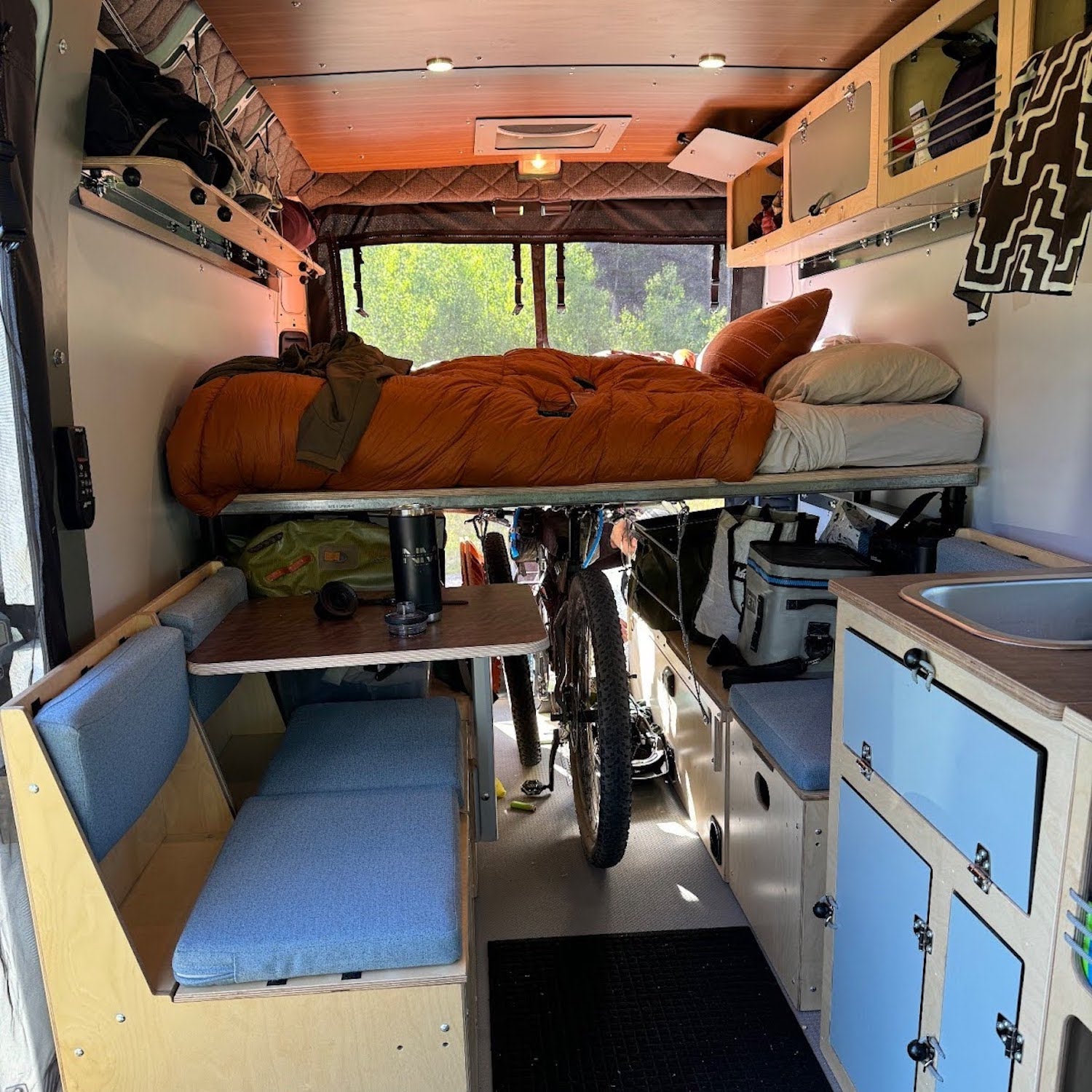I’ve tried just about every type of camper there is over the years. In addition to testing for ���ϳԹ���, I’ve personally owned a teardrop, a Casita travel trailer, two shell-style truck campers, an Airstream, and even my own homemade slide-in truck camper (yes, I have a rig problem). And yet, while we’ve been willing to try pretty much every other setup on the market, my wife Sarah and I have always stuck to a single hard guideline: No vans.
We have never been van people. Sarah and I both find most of them too loud, awful to drive in the wind, not very capable off pavement, and, most importantly, prohibitively expensive. So, you can imagine my surprise earlier this year when Sarah looked me in the eye and said she wanted to take a van on an upcoming cross-country trip.
Actually, surprise might be an understatement. We have a perfectly good Tundra clad with a sitting in the driveway, next to a 2005 Airstream Bambi we’ve been remodeling over the last few years. What could a van do that our campers couldn’t?
A lot, it turns out. But first, some background on the trip. This spring, I was deep in the final planning stages of a 2,700-mile bikepacking trip along the Great Divide Mountain Bike Route. My plan was to leave Antelope Wells, New Mexico, on June 1 and arrive in Banff, Alberta, sometime around July 15th. Sarah’s not a cyclist but she wanted to join for part of the trip. The plan was for her to meet me along the route somewhere in Montana and be the sag wagon for the last two weeks of the ride, after which we’d road trip home together.
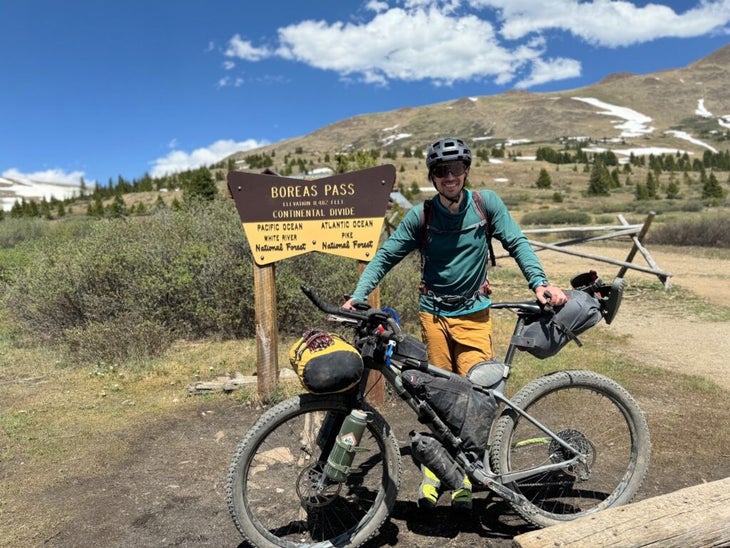
She thought the trailer would be too cumbersome for some of the roads we’d be driving and a pain to maneuver through cities. Plus, understandably, she didn’t want to pull the thing by herself. The Tundra/Tune combo, while a perfect rig for off-road adventures and shorter trips, isn’t enormously spacious—or easy to work remotely from. Sarah also brought up something up I had never had to consider as a white male: a van would offer her more security as a solo female traveler since she wouldn’t have to get out of the vehicle, or pop anything down to leave if she felt uncomfortable somewhere.
So, I reluctantly set about looking for a van to try. Though, deep down, I was also a little excited (I do love a new rig, even if I never pictured myself giving #vanlife a try).
At this point, I’d been following for several years. The Colorado Springs-based brand originally offered interior kits for DIY builders, and have since switched to doing conversions themselves. In a world of $250,000, ostentatious Sprinter van builds, the idea of a high-quality camper conversion that sounded almost too good to be true. Only one way to find out: I called them up and asked about testing one of their vans. We ended up choosing a slightly more kitted out, $24,500 build dubbed “.” Here’s how it went.
Wayfarer Vans Walt Build: Review
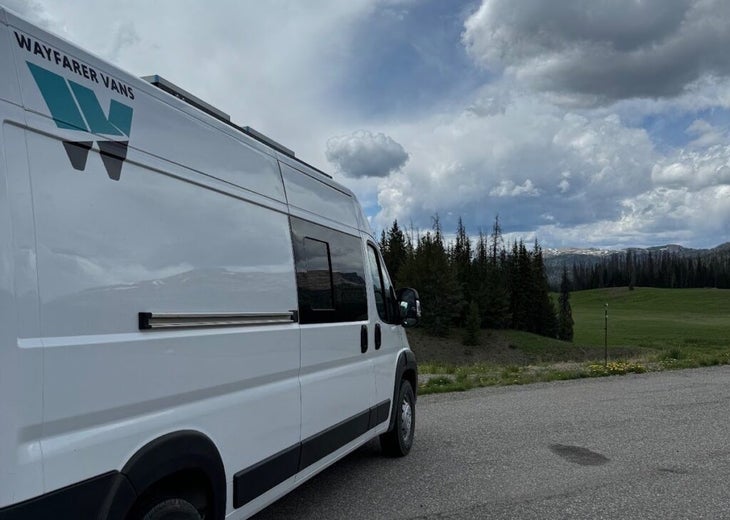
If you buy through our links, we may earn an affiliate commission. This supports our mission to get more people active and outside. Learn more.
How Wayfarer Works
Unlike custom van builders, which will do just about anything to any van, Wayfarer keeps costs down by only of Ram ProMasters and Ford Transits. You can bring them a new or used ProMaster or Transit, so long as it’s a 2014 or newer. These vans cost less than Mercedes Sprinters—and typically have lower maintenance costs. It’s usually a lot easier to find a Ford or Ram dealer for service.
Wayfarer offer four builds—dubbed the Walt, Walter, Wilma, and Wilford—which each correspond to the different van models, as well as a couple layout options within each build. But perhaps the biggest perk of going with Wayfarer is the time a conversion takes. Since they stick to a set number of models and floor plans, they have all their materials on hand and their builds dialed. That means they can convert a van in just a couple of days. To put that into perspective, a lot of van builders take weeks to complete a conversion. I’ve even had friends wait for more than six months for a build on a new van.
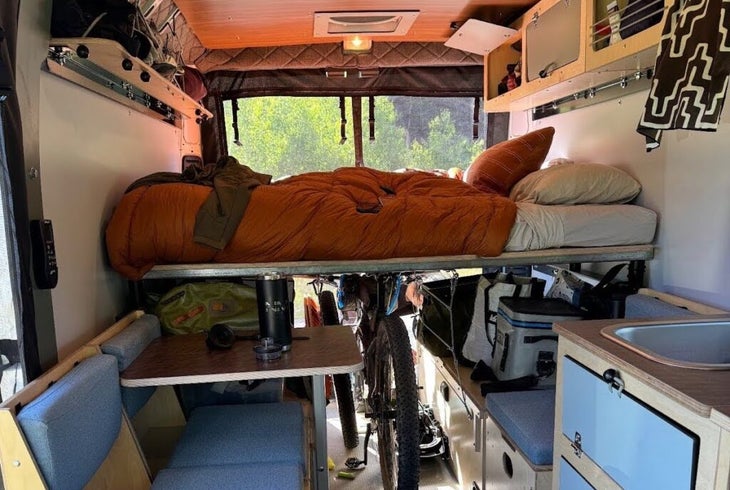
The Build
The demo van we tried was a , which is based on a 159” wheelbase, high-roof Ram ProMaster 2500. The buildout consisted of a galley cabinet with a sink and flip-up counter space, seating for three, a bed in the back, boot boxes, and overhead storage cabinets and compartments. For the furniture, Wayfarer uses UV-treated, 9-core baltic birch that’s water- and scratch-resistant, while the walls, ceiling, trim, and cabinet doors are composed of laminated composite materials.
Soft panels cover any other exposed surfaces, like the wheel wells. Wayfarer insulates each van with 100-percent wool batting, and includes sound-deadening insulation in the subfloor. All that insulation, along with smart touches like the soft panels over the wheel wells, gravity hinges, and more, contributed to a very quiet cabin and pleasant driving experience.
There were also LED lights in the ceiling and an insulated partition (which you can easily roll up and store out of the way) to separate the living space from the cab. Magnetic window coverings for rear windows are also included in the $24,500 base price. Our demo van had some bonus features, like a Propex heater, extra storage cabinets, and for the doors. (Wayfarer will add any of these to your own build for an additional fee.)
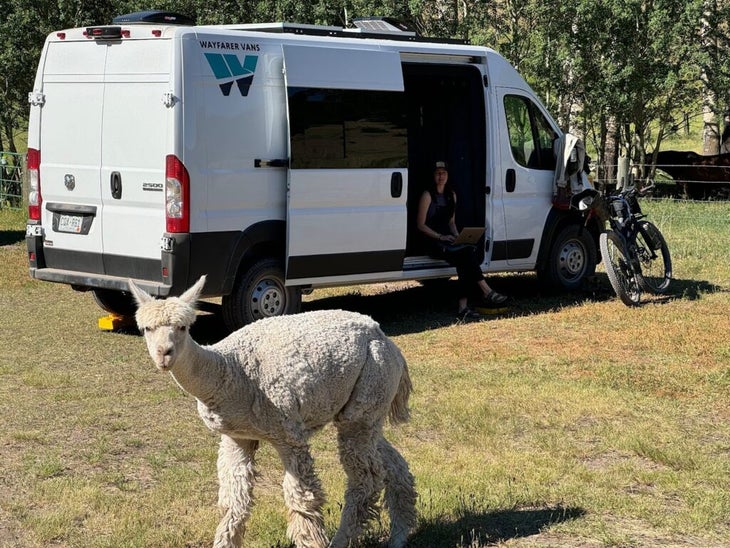
The Test
Sarah picked up our van at Wayfarer HQ in Colorado Springs and spent a few days road tripping through Wyoming and Montana, and finally met me outside of Lima, MT. By the time she caught me, she was already smitten with the van. The lower exterior height of the ProMaster and driver’s seat—which sits higher than that of a Sprinter or Transit, and offers a better view of the road—had proven to be far more comfortable for her, and the van seemed significantly less affected by wind gusts on the highway than the other vans we’ve driven. It was also much quieter than previous vans we’d tested, presumably due to the lower roof height of the ProMaster and the amount of insulation Wayfarer uses to deaden road noise. And, thanks to the quality of the interior build, there was no noticeable rattle from cabinet doors or fasteners.
We’d most recently tested a 144-inch wheelbase, high-roof Sprinter equipped with an interior build from , which takes a different approach to interiors. ���ϳԹ��� Wagon opts to keep things modular with a lot of aluminum components. While we liked that van’s minimalist build, we found the interior was so loud you could barely hold a conversation at highway speeds, and we felt the Sprinter’s “Crosswind Assist” feature was overly intrusive—and even a bit scary. Obviously there’s a lot that goes into making a van’s interior quiet, including the dimensional differences of the Sprinter and ProMaster (a high-roof ProMaster sits almost 10 inches shorter than a high-roof, AWD Sprinter, for instance), but clearly Wayfarer has figured out some secret sauce to keeping their interiors quiet, too.
After spending more than a month living out of a one-person tent, I felt like a king once Sarah arrived—despite the fact that Walt isn’t the fanciest van I’ve spent time in. Compared to something like a Winnebago Revel, ���ϳԹ��� Van, or Storyteller Overland Build, it’s much more utilitarian—but I actually appreciate that. The modern interior design is simple but beautiful, the cabinets and furniture feel extremely well built, and it doesn’t feel so fancy that you feel bad about tracking dirt and messy gear inside. It feels like it was made to be used as an adventure rig, not a showpiece.
View this post on Instagram
The longer we spent living in the van, the more we both grew to really appreciate Wayfarer’s simple approach to the build. In lieu of a complex, expensive electrical system, they power the camper’s lights, fans and fridge with a that charges via the van’s alternator and two solar panels on top. Instead of a traditional plumbing system with pipes to freeze and a water pump to break, two five-gallon water containers (one for fresh, one for gray water) sit under the sink. To get the sink flowing, you simply work a small hand pump. That saves water—and means you never have to winterize anything since you just pull out the jugs or empty them when it gets cold. There’s no shower or bathroom, but there is space for a portable composting toilet. We just brought along our and rinsed off outside.
Downsides? Truthfully, I couldn’t find many. It was never really cold enough for us to use the Propex heater, but I could see some people preferring a gasoline-powered heater like a or that could be plumbed directly to the van’s gas tank, eliminating the need for an additional fuel source. I’ve had good luck with Propex heaters in other rigs, though. Also, at six foot one, the van’s bed in the “regular” layout we had was too short for my six-foot-four frame. There’s an option for a “long” layout, but you lose some seating to accommodate the longer bed, which is a bummer.
Top Takeaways
The van’s simplicity reminded us that a lot of rigs, including our Airstream, are overly complex, and filled with “luxuries” that, while seemingly nice, just tend to break and become one more barrier to getting out and enjoying a trip. For instance, while our Airstream has an oven with a built-in stove, a propane-powered fridge and a shower inside, we’ve had our propane system leak and our water pipes freeze up. The trailer, and a lot of rigs, also have complicated power systems with wiring diagrams that you need to be an electrician to understand, let alone fix if something goes out. We had zero issues with any of the components in the Walt during our time in it, and I can’t really imagine having any given that there’s not much to fail or maintain.
We also found the ProMaster to be plenty capable, and we put the Wayfinder build to the test on some seriously sketchy roads. Once, Sarah was forced to spend several hours driving a dirt “road” near Glacier National Park that turned into a rough two-track and then a shelf road over a mountain pass. It was slow going, but she made it, and the interior stayed rattle-free. We’ve taken more expensive campers down lesser roads and had cabinets fall off of walls, refrigerator doors break, and more, which is a testament to Wayfarer’s build quality.
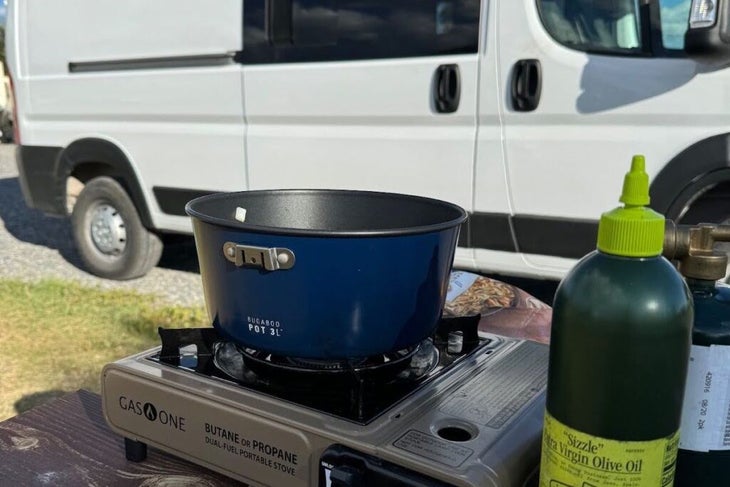
I think the thing I appreciated most about the van and Wayfarer in general is the value proposition. I’ve always been drawn to value-oriented rigs to review because I think that’s what most folks can afford. Besides, nobody needs a $250,000 Sprinter, EarthRoamer, or other crazy expedition rig. With builds starting at $21,200 (or $24,500 for the Walt model we tried), and some ProMaster models starting around $50,000, you could realistically get into a brand-new camper van for under $75,000, which is almost unheard of these days. Bring Wayfarer a used van, and you can cut that cost down even more.
To be completely honest, I wasn’t expecting us to like the van as much as we did. I sort of assumed it would work for the trip, but we’d return the van and quickly forget about it. I couldn’t have been more wrong. Since we got back, we keep finding ourselves wishing we still had Walt. We’ve even passed on a few last-minute trips because they sounded like too much work without a van, or we decided they would burn too much gas in the truck (we averaged about 20 mpg in the ProMaster, versus about 13 in my Tundra).
We’re so smitten, in fact, that we will be buying a van of our own, and bringing it to Wayfarer for a Walt conversion later this year. If that doesn’t tell you what I thought of the Wayfarer Vans Walt, I don’t know what will.


